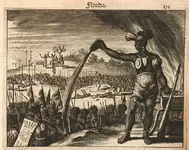From The Memoir of
Hernando D’Escalante Fontaneda
Written in 1575, nearly ten years after his rescue (1565) after having living seventeen years among the Indian tribes of south Florida (wrecked there about 1548.);
“The country of the kings of Ais and of Jeaga is very poor. It contains neither gold or silver mines, and, to tell the truth, it is only the sea which enriches it, since many vessels laden with precious metals are shipwrecked there; such as the Farfan, and the Howker. On board of the latter was Anton Granado and Captain Juan Christobal, whom the natives made slaves; and killed Don Martin De Guzman, Captain Hernando De Andino, and Juan Orvis. On board of this ship were the sons of Alonso De Mesa and their uncle. They were all rich, and I the poorest among them, yet had twenty-five pesos of fine gold. My father and my mother had both served his Majesty in Peru, and subsequently in Carthagena, were they established a colony. I, as well as one of my brothers, was born there. They were sending us to Spain to be educated when we were shipwrecked on the Florida coast; as well as the fleet from New Spain, commanded by the son of Don Pedro Menendez.”
“That he was only a sailor on one of the shipwrecked vessels of the fleet, and ignorant of the fate of the others until after he had talked with the Indians who went armed to the coast of Ais and returned with very considerable riches, in the form of ingots of gold, sacks of Spanish coins, and quantities of merchandise.”
“I will say no more now on this subject, but proceed to speak of the wealth which the Indians found in bars of gold and Mexican jewelry belonging to the shipwrecked passengers, amounting to more than a million. The chief retained the best part of it for himself, and divided the remainder among the Indians of Ais, of Jeaga, of Guacata, of Mayajuaca, and of Mayaca. Most of the vessels or caravels, as I stated before, which had been shipwrecked there were from Cuba and Honduras, and going in search of the river Jordan, which explains how the Indians of Ais, of Jeaga, and the Guardgumve Islands became so enriched by the sea and not by the land.”
Narrative of Le Moyne, 1564;
This after speaking with two unidentified shipwreck survivors who had survived among the Indians of south Florida;
They also reported that he (King Carlos) possessed a great store of gold and silver, and that he kept it in a certain village in a pit not less then a man's height in depth, and as large as a cask; and that, if I could make my way to that place with a hundred arquebusiers, they could put all that wealth into my hands besides which I might obtain from the richer of the natives. They said further that, when women met for the purpose of dancing, they were, hanging at their girdles, flat plates of gold as large as quoits, and in such numbers that the weight fatigued and inconvenienced them in dancing; and that the men were similarly loaded. The greater part of all of this wealth, they were of the opinion, came from Spanish ships, of which numbers are wrecked in that straight; the rest from the trade between the king and other chiefs in the neighborhood.”
There is no evidence that any of this accumulated wealth was ever recovered. However, what is clear is that numerous richly laden ships did wreck on the coast of Florida during the early and mid 1500’s and that they were close enough to shore to be easily salvaged by the south Florida Indians. Also take notice that both accounts reference “fleets” when speaking of these wrecks. Thus far, to my knowledge, records have not provided details of wrecked “fleets” on the Florida coast prior to 1555 but it is certain that they did occur as early as the mid to late 1840’s (Fontaneda was a survivor of one such wrecked fleet in the late 1840’s.) Also keep in mind that these vessels were much smaller ships, “caravels” that most likely, due to their shallower draft, would have been swept closer to shore atop the increased storm swells.
It’s also interesting to note that a great deal of this treasure passed through the hands of the Ais & Jeaga and deep into the mainland, and possibly even reaching as far as the west coast Indian villages. The Jeaga were south of the Ais, which serves to provide a possible hint that many of these wrecks took place further south then that of the discovered 1715 wrecks. It is a vast expanse of ocean and beach but we do know there is a lot of history and wealth out there, and a great deal of it is very likely closer to shore then we realize, some of it already known to be on shore. All trace of these ships is probably gone except for the more resilient cargoes they have left behind. But clearly it is there, somewhere, and it is near certain that is there in great quantity. One day a researcher will be busy examining the documents in the archives and they are going to come across that first fantastic document or clue, I have little doubt in that. I also have little doubt that the preceding discovery will dwarf that of the 1715 fleet if laws don’t prevent it’s discovery and salvaging. When one considers the era in question and the preceding conquest that took place, there is little doubt of the extraordinary discoveries that await.



 It's just one of those mysteries that drives me.
It's just one of those mysteries that drives me.




